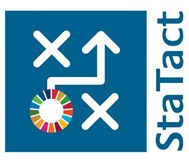United Nations Statistical Commission
Overview 50th Session (2019) Side Events

StaTact, a fast-tracking solution
to data gaps
- Tuesday, 5 MAR 2019
- 8:15 – 9:30 am
- Conference Room C
Meeting organized by UNITAR and UNSD
Side event open to all interested participants of UN Statistical Commission and organized by United Nations Institute for Training and Research (UNITAR) and United Nations Statistics Division (UNSD)
Objective
The objective of the side event will be to showcase the new, upgraded, interactive and fully web-based version of the new UNITAR-UN Statistics Division tool - StaTact 2.0 - and explain the StaTact process to those who might be interested in joining it.
-
Moderator:
Mr. Gabriel Gamez, Inter-Regional Advisor, UN Statistics Division -
StaTact process and StaTact demo by
Ms. Elena Proden, Specialist, UNITAR and
Mr. Geoffrey Greenwell, UNITAR -
Experience of Grenada by
Mr. Halim Brizan, Chief Statistician, Grenada -
Experience of Togo by
Mr. Kouassi Koame, Chief Statistician, Togo -
Questions from Asia-Pacific region by
Ms. 'Ofa Ketu'u, Chief Statistician, Secretariat of the Pacific Community -
Other questions, answers and discussion
What is StaTact 2.0?
Ever faced a challenge on how to
- raise the awareness around real value and need to base decisions on quality data?
- provide youth unemployment data that can meaningfully inform national social protection, educational, economic and other policies and local programs through better coverage and disaggregation by relevant characteristics?
- make the GDP figure available faster to inform a timely development of the annual plans, improve projections and upgrade models used by policy-makers to take decisions?
- ensure geographically disaggregated data to help prioritize schools for meal plan subsidies?
- strengthen availability of high quality disability-disaggregated data?
- improve rural unemployment data to better target employment and training programs?
- or else improve availability of quality data on populations in disaster-prone areas to agencies responsible for ensuring disaster response and mitigation?
You will surely think all these problems will require costly solutions in the context of low and middle-income countries. Many are part of national statistical development strategies or plans but progress is looming due to resource or other limitations.
StaTact was developed by UNITAR and UNSD to help address some of these issues in a quick and non-costly way through collaboration and short-term action planning. It does so in a context-sensitive manner by setting up collaborative alliances between NSOs, other official and non-official data producers and key data users - each around a specific challenge.
Against the backdrop of the SDGs and the growing awareness around value of data, this new tool also aims to help countries prioritize their SDG data needs in a short term through dialogues in working groups – online and offline - and address those data gaps that are most policy relevant.
StaTact can also support the implementation of national statistical development strategies or plans by addressing areas with little progress and helping to move the agenda.
Unlike the first, static version of StaTact, StaTact 2.0 offers such additional features as opportunities for online interactions between key concerned stakeholders before, after or independently of the workshops through working groups around selected issues. It also features significant add-ons in terms of visualization of action plans and related budgets that can support advocacy with key stakeholders and donors, as well as a mechanism to monitor implementation.
What is StaTact process?
This tool has already been used by 15 countries, and it is expected that 15 more – all Small Island Developing States - will use it by July 2019.
The introduction of the online version creates significant scope for the tool to be used on a much larger scale in an independent manner and allow working groups convene, evolve and reconfigure in a demand-driven way. The integrated follow-up and monitoring system will provide an opportunity for easy and transparent tracking of progress and improved collaboration.
A new e-learning course on data governance and a StaTact manual will help StaTact users better leverage the tool. Finally, such innovations as a system of focal points and SDG champions will help sustain commitment, transform mindsets and ways of doing things and enable a broad and regular use of StaTact methodology.
Come and try StaTact and become the next StaTact Champion!